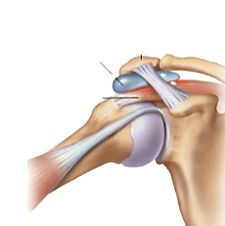Strains and sprains
_edited.png)
What is muscle or tendon strain?
The muscles, ligaments, or tendons in your shoulder may stretch or tear if abnormal forces are put on the tissues. This injury can cause inflammation, pain, and inability to use the muscle as before and may predispose you to shoulder joint problems. Strains and sprains often happen in the shoulder as this joint is very mobile.
There are multiple muscles around the shoulder joint, including rotator cuff muscles, trapezius, deltoid and rhomboids. These muscles stabilize your shoulder and allow you to move it in different directions. Any muscle or tendon strain and sprain may cause you pain. Rotator cuff injuries are the most common muscle or tendon injuries in the shoulder.
What is a rotator cuff?
A rotator cuff is a group of four muscles and tendons that surround the shoulder joint, keeping the head of the upper arm bone firmly in the shoulder's shallow socket. The rotator cuff attaches the humerus to the shoulder blade and helps to lift and rotate your arm.
Rotator cuff injuries are common and increase with age. The rotator cuff starts to weaken around the age of 30. Many people are unaware of these changes because they don't always cause pain. Tendinosis changes are a normal part of the aging process and usually don't need to be treated unless they cause pain.
What causes rotator cuff pain?
Rotator cuff pain is fairly common. Pain can be the result of different injuries to the rotator cuff, including:
-
Tendinitis - when the rotator cuff tendons becomes inflamed.
-
Bursitis - when the fluid-filled sac between the tendon and the bone becomes inflamed and swells, causing pain.
-
Impingement - when the space between the bone and rotator cuff narrows, causing irritation and pain.
Rotator cuff injury is common in both young athletes and middle-aged people. Young athletes who take part in overhead sports like swimming and tennis are more susceptible. People doing repetitive lifting or overhead activities using their arms, such as construction or painting, are also susceptible.
Symptoms of rotator cuff injury
Rotator cuff pain usually causes local swelling and tenderness in the front of the shoulder and pain and stiffness when you lift your arm. More severe injury to the rotator cuff results in:
-
Pain at night
-
Loss of strength and motion
-
Difficult to comb your hair or reach behind your back
-
Arm weakens
What is biceps tendinitis?
Biceps tendonitis is an inflammation of the long head of the biceps tendon that connects the shoulder to the elbow. It often results from repetitive overhead motions such as swimming and tennis.
Symptoms of biceps tendonitis
The severity of symptoms varies significantly from patient to patient. The symptoms are not constant for some patients but may come and go. Symptoms of bicep tendonitis may include:
-
Pain in the front of the shoulder which worsens with overhead lifting or activity.
-
An occasional snapping sound or sensation in the shoulder
When should I seek medical help?
There are circumstances when shoulder pain might be caused or accompanied by severe issues. If such symptoms are present, it is best to seek immediate medical attention to avoid further complications:
-
Shoulder pain with a fever, swelling, or redness
-
Difficulty sleeping due to pain or discomfort of the affected shoulder
-
Difficulty or pain when attempting to reach backwards, raise your arm over your head, or reach across your body
-
Pain for more than two weeks, even after home treatment
-
Deformed joint
-
A previous dislocation of the shoulder
Diagnosis
To diagnose any rotator cuff injury, your doctor will take your case history and past medical history into account. They will check to see if it is tender in any area or if there is a deformity. They will measure the range of motion of your shoulder and will have you move your arm in several different directions and test the strength of your arm.
Your doctor will check for other problems with your shoulder joint. They may also examine your neck to ensure the pain is not from a pinched nerve and rule out other conditions, such as arthritis.
Other tests which can help your doctor confirm your diagnosis include ultrasounds or MRIs. Ultrasound and MRI scans can show the state of your rotator cuff tendons including any tears, as well as any inflammation in the surrounding structures such as bursa.
Treatment
The goal of treatment is to reduce pain and restore function. Nonsurgical treatment may take several weeks to months, and many patients experience a gradual improvement and return to function. Some examples of non-surgical treatments includes:
-
Rest. Your doctor may suggest rest and avoiding overhead activities.
-
Non-steroidal anti-inflammatory drugs (NSAIDs). Drugs like ibuprofen, aspirin, and naproxen reduce pain and swelling.
-
Physical therapy. The initial focus would be on restoring the shoulder's range of motion. After the pain improves, the physiotherapist may suggest strengthening exercises.
-
Steroid injection. A cortisone injection may be helpful if rest, medications and physical therapy do not relieve your pain.
If nonsurgical treatment fails to reduce pain or improve mobility, your doctor may suggest surgery. Surgery aims to create more space for the rotator cuff by removing the inflamed portion of the bursa. Shoulder surgery is often done by arthroscopic technique, a minimally invasive procedure. In arthroscopy, thin surgical instruments are inserted into two or three minor puncture wounds around your shoulder.
Prevention of shoulder tendinitis and tears
There are multiple ways to prevent shoulder tendinitis and tears, these include:
-
Exercise and strengthening the rotator cuff.
-
Keeping good posture. Roll your shoulders backwards and avoid leaning your neck forward while sitting.
-
Avoiding sleeping on one side with your arm stretched overhead.
-
Quitting smoking as it decreases blood flow to the rotator cuff and reduces their ability to heal.
-
Avoiding activities with repetitive overhead arm action.
-
Warming up before working out.